Colorful with a noisy personality to match, this is the cockatoo!
Now I have owned an African Grey parrot, aptly named Kasuku, which is Swahili for, you guessed it, parrot.
Having taken him in as a rescue as an adult, at times, it was very much hit and miss, but over time and with a lot of research from my end, he and I formed a strong bond.
And conversely, the same can be said of a Cockatoo who is also a member of the parrot family.
Fun and fascinating, they can make great family pets and provide hours of amusement with their antics.
But it goes without saying that these pet cockatoos cannot be left languishing in cages without stimulation or very little human interaction.
This article looks at these popular pet birds and more about their species.
Taxonomy
The English naturalist George Robert Gray first defined Cockatoos as a subfamily (Cacatuinae) within the parrot family back in 1840.
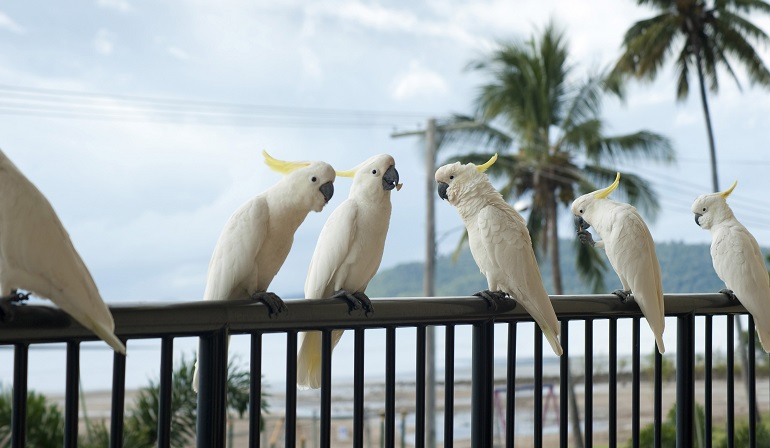
Genera and Species
The cockatoo belongs to the family Cacatuidae and is the only family in the superfamily Cacatuoidea, with its 21 species forming part of the larger order Psittaciformes (parrots), which contains more than 360 species of generally brightly colored and noisy birds.
Scientific Classification
A cockatoo is one of the species of parrots belonging to the family Cacatuidae, the only family in the superfamily Cacatuoidea.
Etymology
Interestingly enough, the word cockatoo dates as far back as the 17th century and came about from the Dutch kaketoe, which is from the Austronesian language Malay.
Variants on the name during this time included crockadore, cacato, and cockatoo. And by the 18th century, cokato, cocatoo, and cocatore were also used in reference to this bird.
Morphology of Cockatoos
Despite being classed as a part of the larger parrot family, the 21 species of cockatoo come with their own distinct features that set them apart from true parrots.
Yes, they have a waddling gait just like other parrots and share the same common traits such as a curved beak, short legs, strong claws with a zygodactyl foot, and the ability to fly, but that is where most of the similarities end.
Cockatoos have a different arrangement of carotid arteries, a gall bladder, and even differences in their skull bones.
In fact, cockatoos are visually different from parrots due to their lack of Dyck texture feathers.
And as a result, this bird species does not scatter light in such a way as to produce the vibrant blue and green colors often found in many parrots.
As such, cockatoos have predominately white or black plumage with hints of yellow, pink, or red, and in some species, you find a brightly colored area of bare skin around the face and eye known as a peri ophthalmic ring.
But what truly sets the cockatoo apart is the adjustable feather crest on top of their head which they use to great effect to make themselves look bigger or when the bird is showing off.
This bird species is generally medium to large, of stocky build, has a length that ranges from 12 to 24 inches, and can weigh anything up to two and a half pounds.
Cockatoos generally have long broad wings which can reach speeds up to 43 miles per hour which were recorded on Galah Cockatoo.
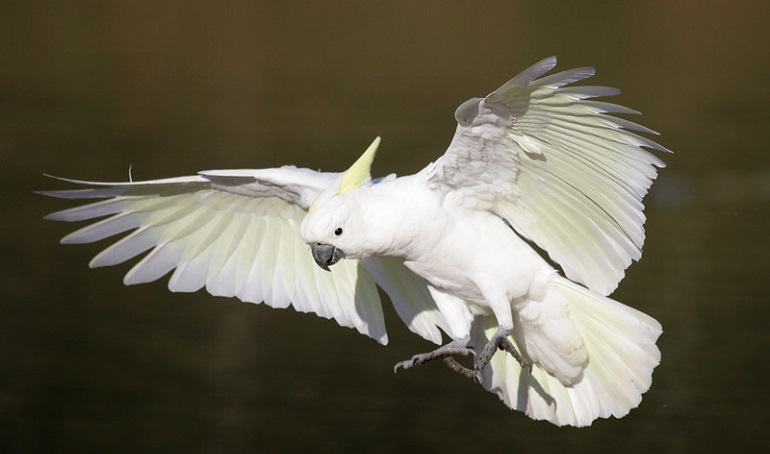
But having said that, larger cockatoo species such as Major Mitchell’s and the Sulpher-Crested cockatoos are also known to have rounder, shorter wings.
Interestingly enough, cockatoo birds also use their strong bill as a third limb when climbing branches.
And it is this large bill aided by their muscular tongue which helps dehusk the seeds they are eating. In fact, cockatoos keep their large bills sharp by rasping the two jaws together when resting.
Male cockatoos are generally slightly larger than females and present with dark brown irises.
While in contrast, some female cockatoo species, such as the Galah and Major Mitchell’s cockatoo, the iris color presents as pink or red, or even brown-red in the white female cockatoo species.
To maintain their plumage, cockatoos frequently preen their feathers throughout the day. By doing so, they remove oil and dirt and realign feather barbs.
Interestingly enough, cockatoos also preen other birds’ feathers that are hard to get at.
Molting in this bird species is a complex and prolonged process. In black cockatoos, for instance, it can take two years to complete, while in the long-billed Corella, it can be much shorter at around six months.
The Different Species of Cockatoo
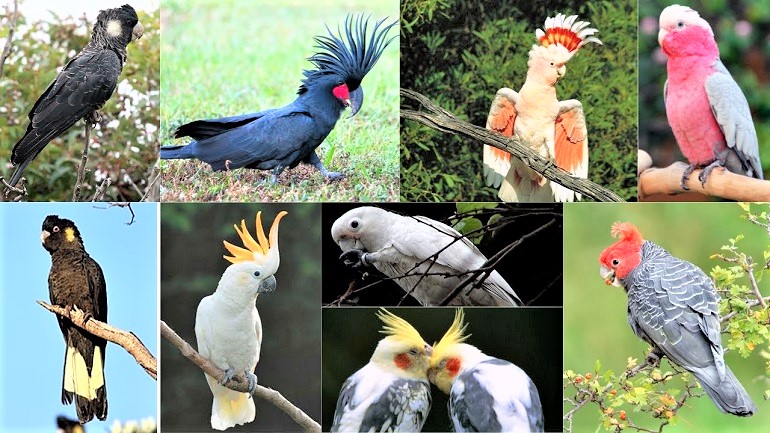
In order to simplify the Cockatoo bird species even further, here is a brief breakdown of the 21 different types of Cockatoos.
- Galah Cockatoos
- Blue-Eyed Cockatoos
- Cockatiels
- Ducorps Corella
- Baudin’s Black Cockatoos
- Glossy Black Cockatoo
- Goffin’s Cockatoos
- Carnaby’s Black Cockatoos
- Major Mitchell Cockatoo
- Little Corella
- Slender-Billed Corella
- Western Corellas
- Gang-Gang Cockatoos
- Moluccan Cockatoos
- Palm Cockatoo
- Yellow-Crested Cockatoo
- Red-Tailed Black Cockatoo
- Red-Vented Cockatoo
- Sulphur Crested Cockatoo
- White Crested Cockatoos and
- Yellow-Tailed Black Cockatoo
Native Region / Natural Habitat
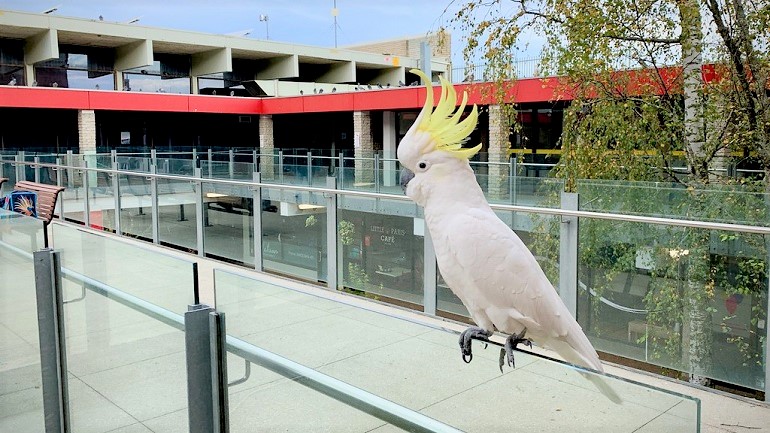
Cockatoos are typically native to the tropical and subtropical regions of Indonesia, Australasia, Papua New Guinea, Australia, and Pacific islands such as the Solomon Islands and Kangaroo Island.
They occupy a wide range of habitats, including mangrove forests in subalpine regions, scrublands, rainforests, and even eucalyptus groves.
With the most widespread of the cockatoo species, the cockatiel, and Galah prefer open country with plenty of grass seeds.
Cockatoo LifeSpan
Cockatoos live an astonishing 60 years or longer, while cockatiels generally have a lifespan of 20 years.
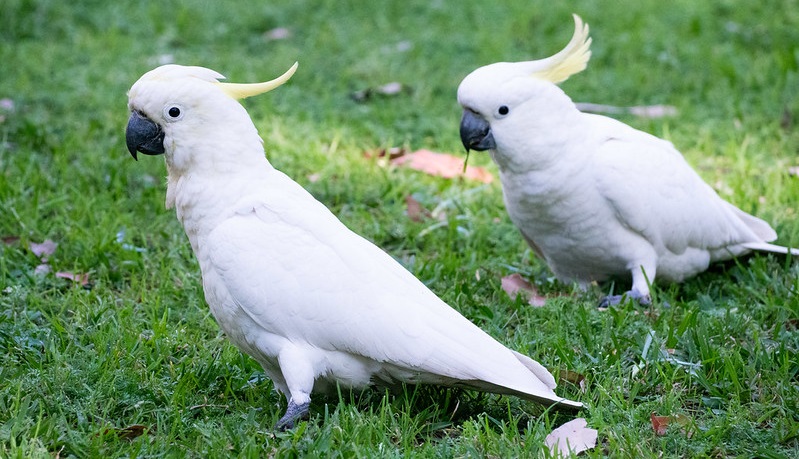
Personality and Behavior
Cockatoos are behaviorally distinct in that they require daylight before they set off to find their food.
In fact, these birds are late risers in the bird world, waiting until the sun has warmed their roosting sites before feeding.
Most of the species are highly social and tend to travel and forage in noisy, colorful flocks in search of food.
Breeding
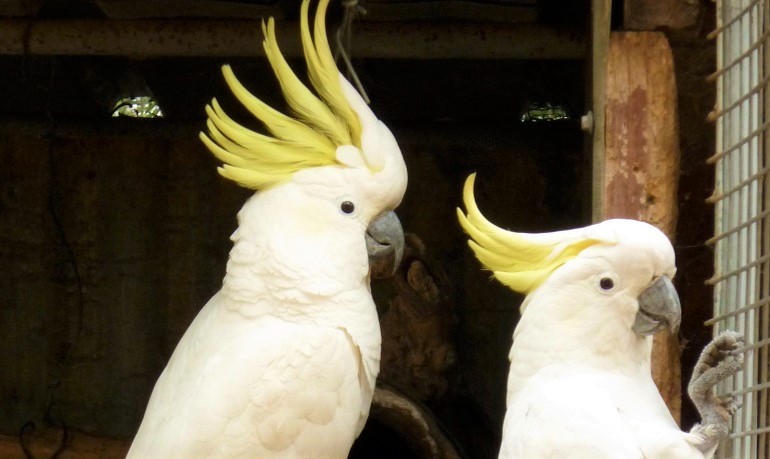
As such, cockatoos are monogamous and form pair bonds that can last many years. These bonded cockatoo pairs then generally look for a tree cavity or hollow to nest.
Interestingly enough, Galahs add leafy branches to the nest before laying their eggs.
Typically with most cockatoo species, both male and female incubate the eggs, of which one to six eggs are laid in a clutch at two to three-day intervals.
The parents only start incubating the eggs once the last one is laid to ensure that the chicks all hatch simultaneously.
And often, most cockatoos will remain with the flock they were raised in.
Diet and Feeding
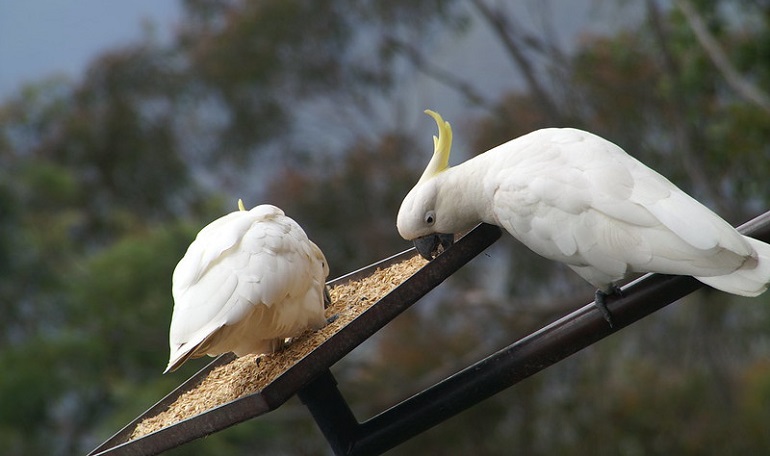
Cockatoos consume a wide range of predominately vegetable food items such as tubers, roots, nuts, and fruits, with seeds forming a large part of their diet.
Some species prefer to forage on the ground for their food, such as corella, black cockatoos, and the Galah, while others feed in the canopy of trees.
Additionally, species such as the Yellow-tailed Black cockatoo take in a large number of insects as part of their diet.
Generally speaking, the amount of time a cockatoo has to spend foraging will depend on the season.
For during times of plenty, these birds may only need to spend a few hours in the morning and evening looking for food. However, they can spend most of the day on this activity in the leaner months of winter and during the breeding season.
Interestingly enough, cockatoos have large crops, which allows them to store and digest food after they have finished foraging.
And when feeding, cockatoo ‘sentinels’ sit close to the flock keeping an eye out for potential danger. And should a threat arise, the sentinel bird sends out an alarm call to the entire flock, which then takes flight.
Predators and Threats
Like other birds, cockatoos are vulnerable to predators from both within their own and other animal species.
Despite reports of eagles and falcons taking down cockatoos such as the Galah and Sulphur Crested cockatoos, it is the nestlings and eggs of the cockatoo that are most vulnerable.
Predators such as the monitor lizard, which can climb trees, the spotted wood owl, pythons, rodents, and the bush tail possum, are all common threats to the young of the cockatoo.
But predators lurk even within their own species, with the Glossy Black cockatoo having been recorded killing Galah and Little Corella nestlings in a competition for nesting space.
But it’s not just predators that pose a threat to these birds. Severe storms that flood nesting hollows and drown the young or termite activity that collapses the nests are among some of the more common threats.
And then, of course, you have human activity, which poses the largest threat of all to this species.
Social Learning
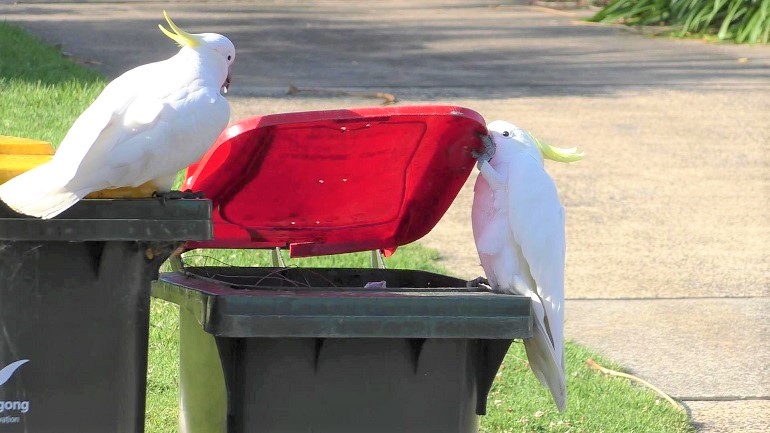
Interestingly, these birds have been shown to learn new skills through social interaction.
In a study conducted in New South Wales, researchers were able to track that cockatoo could spread and teach lid-flipping skills to open garbage bins with each other.
In fact, bin openings by cockatoos in this area spread quickly to neighboring suburbs, with birds in different regions also developing their own variation of accomplishing this complex task.
Speech and Sound
Cockatoos are noisy and are said to be the loudest of all parrots.
But the noise they make serves the vital function of communicating with each other, whether it’s for alerting others in their flock to predators, recognizing one another, or just for the sheer joy of making a noise.
Interestingly enough, some cockatoo species have different calls, with the Carnaby’s black cockatoo having as many as 15, while the Gang-Gang cockatoo is relatively quiet.
In fact, in addition to their calls, Palm cockatoos have a novel way of communicating over long distances by drumming on a branch that is dead with a stick.
Health and Common Conditions
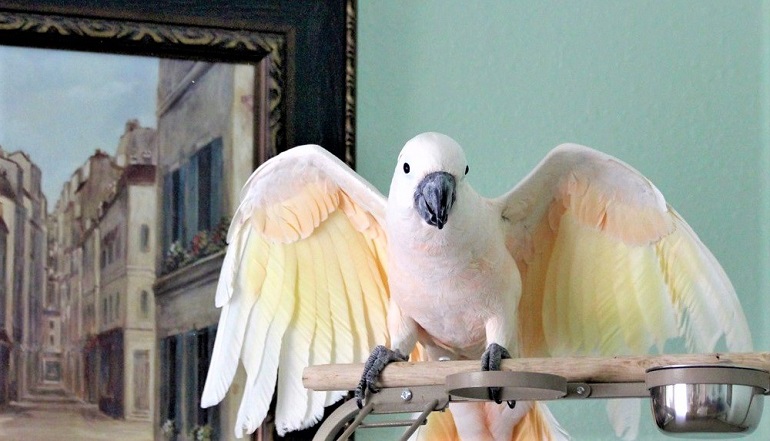
Like parrots, cockatoos can suffer from psittacine beak and feather disease, a viral infection that causes malformation of the beak and feather loss and reduces the bird’s immunity.
Additionally, just like macaws and Amazon parrots, cockatoos can also develop cloaca papillomas, a non-cancerous tumor in the posterior opening of the bird.
While cockatoos as pets can develop obesity and fatty liver disease if fed a diet too high in fat.
Entertainment for Your Cockatoo
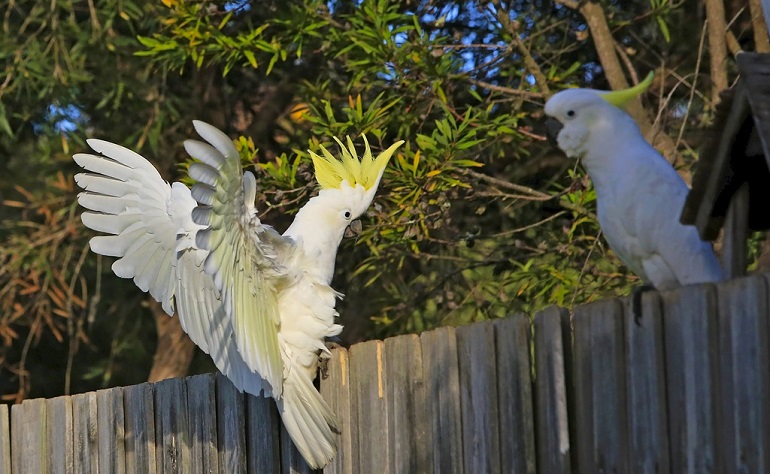
Cockatoos should be given toys of different colors, shapes, and sizes and other enrichment opportunities as well.
Toys such as natural unbleached ropes that can be shredded will not only keep a cockatoo out of mischief but also provide mental and physical exercise.
Untreated wooden toys with movable parts are another great option, as is teaching games such as catch with a little ball and, of course, tricks such as dancing.
Cockatoos’ Intelligence
Cockatoos are intelligent. There is no doubt about that!
In fact, Parrots, macaws, and cockatoos are often considered the most intelligent birds and are among the most intelligent animals in general. It is believed that parrots can get jealous due to the bond they form with others.
Not only can this bird mimic human sounds, sing, dance, and perform tricks. It is also capable of learning new things, according to a recent study, such as how to assemble and craft tools
While interestingly, another research maintains that cockatoos are brighter than four-year-old children.
Cockatoo Fun Facts
Did you know that cockatoos’ contact calls can be heard from up to a mile away, especially in the early morning and near sunset when they would naturally call out in the wild?
Here are some other interesting, fun facts about these intelligent birds.
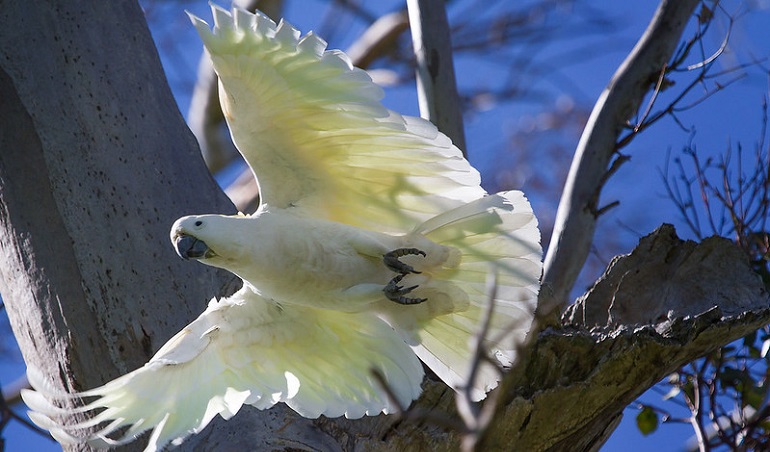
The Crest Feathers
The crest found on the top of the cockatoo’s head is an essential part of the bird’s body language and can tell a lot about how it feels.
A raised crest, for instance, can be a sign of aggression or warning, and it forms part of their natural mating ritual.
But for those birds in captivity, who dance around with their crest up, it could just be the bird showing off to get attention.
Limited Vocabulary
By all means, cockatoos can be taught to speak and, as such, may even learn up to twenty words or simple expressions over the years.
With consistent training, a talkative cockatoo will begin associating certain phrases with specific events, such as saying ‘Good night’ when evening sets in
Cockatoo Family Life
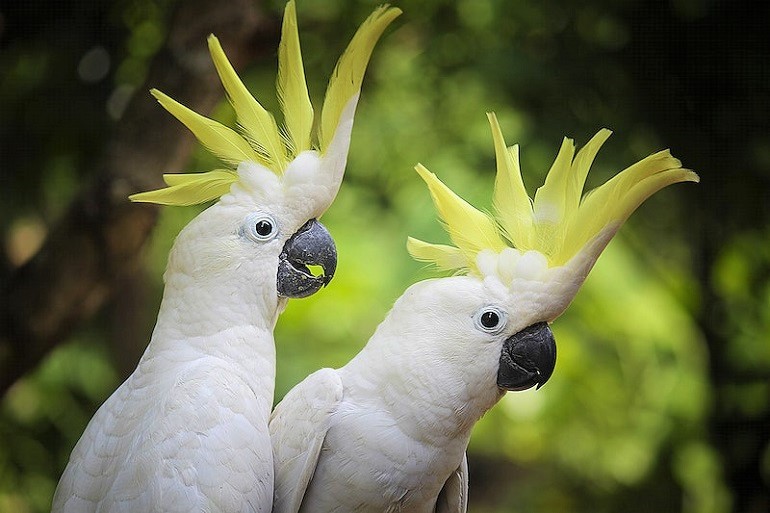
When properly tamed and hand fed from babies, young cockatoos tend to form an extremely strong bond with their owner that will last a lifetime.
They are often referred to as ‘velcro’ birds as they crave petting from their owners and prefer to be near them or on them at all times.
As such, it’s essential that cockatoo owners devote the time and energy required each day to handling and socializing their birds.
But having said that, it’s also important not to overindulge the bird so it can learn to be alone when you are away.
And be advised these birds are prone to depression if they feel they are not receiving enough attention, which can result in destructive behavior and feather plucking.
Relationship with Humans
Undoubtedly the cockatoo species has a complex relationship with humans.
On the one hand, they make adorable and amusing pets and can even bond with their owners for life.
While on the other hand, they would not be in this position if it were not for the destruction of their native habitat and the wildlife trade in them.
Pests
Unfortunately, as agricultural land and urban buildings have destroyed and overtaken their natural habitats, this has resulted in some cockatoo species being labeled as pests.
Capable of not only crop damage on agricultural land, these birds, especially Galah’s and Red-tailed black cockatoos, have been known to strip electrical cabling and tarpaulin in rural areas.
While other targets in urban areas for this bird species include stripping silicone sealant from windows and chewing wire from external fixtures such as television antennae, satellite dishes, and solar water heaters.
In addition, they are also known to be partial to decorative wooden items, wooden outdoor furniture, and window and door frames.
Controls to deal with the threat posed by these cockatoos include shooting, poisoning, or gassing once captured.
While non-lethal damage control consists of methods using scare tactics, habitat manipulation, or the provision of decoy food dumps to distract them from the main crop.
Status and Conservation

The most significant threats to cockatoos are habitat loss and the wildlife trade.
This is especially true of the forest-dwelling species of cockatoo that have suffered a decline in population due to deforestation activities that have destroyed their natural habitat.
In addition, cockatoos make popular pets. In fact, in the 1970s, there was a sudden and dramatic decrease in their numbers in the wild due in part to a Triton cockatoo landing a role in the TV show Baretta.
In fact, between the years 1983 and 1990, Indonesia exported some 66 000 Salmon-Crested cockatoos due to the wildlife pet trade.
Aviculture
Kept for their appearance, engaging personalities, and intelligence, cockatoos can be problematic birds unless they are in the care of owners experienced in keeping parrots.
As social animals, they can suffer if kept in a cage on their own or for long periods as they require interaction.
In fact, in a survey conducted among birdkeepers in the US, only three percent had other cockatoo species as opposed to the 39 percent that had cockatiels.
As such white cockatoos are more often encountered in aviculture than black cockatoos
Culture
Throughout history, different species of cockatoo have appeared, with their first depiction being in a falconry book written in the 1240s by Holy Roman Emporer Frederick II.
Since then, this bird species has appeared in books, paintings, and as decorative motifs through the centuries.
In fact, cockatoos have been used in films, advertising campaigns, and corporate livery for an airline, with the Gang-Gang cockatoo adopted as an official faunal emblem by the Australian Capital Territory in 1997.
Cockatoo Conservation
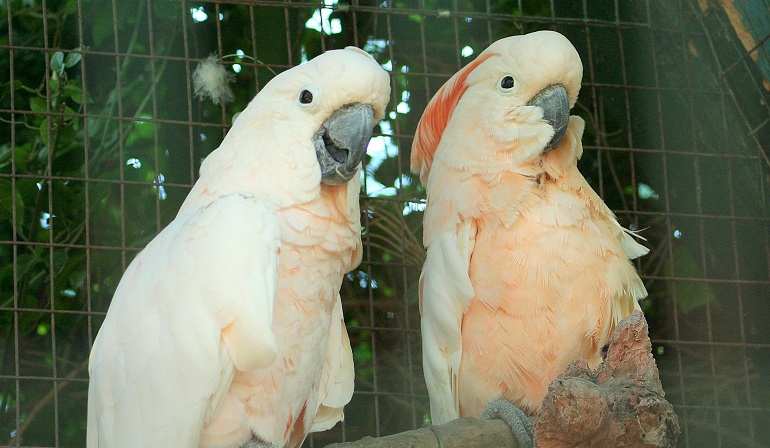
At present, seven species of cockatoo are considered to be vulnerable, with one of them being classed as near threatened by the International Union for the Conservation of Nature
Of these seven species, the Yellow Crested and Red Vented cockatoo are listed as critically endangered.
This has resulted in the capture of many species of cockatoo being banned, but the wildlife trading of these birds continues nonetheless, despite being illegal.
As such, the Convention on International Trade in Endangered Species of Wild Fauna and Flora protects all species of cockatoo, barring the cockatiel by restricting their export and import.
Conclusion
As always, before committing to acquiring a cockatoo, it is imperative that you carry out the necessary research on the requirements of owning this species of bird.
In fact, many cockatoos are given up for adoption due to behavioral reasons, which makes it all the more important to consider this decision carefully.
Ideally, speak to an experienced avian behaviorist, cockatoo breeder, or bird rescue organization to obtain all necessary information on the species.
Cockatoos are known to have a long lifespan, and if you are happy that you can confidently and fully commit to this species of bird for that amount of time, then you are setting yourself up for a great companion pet!












